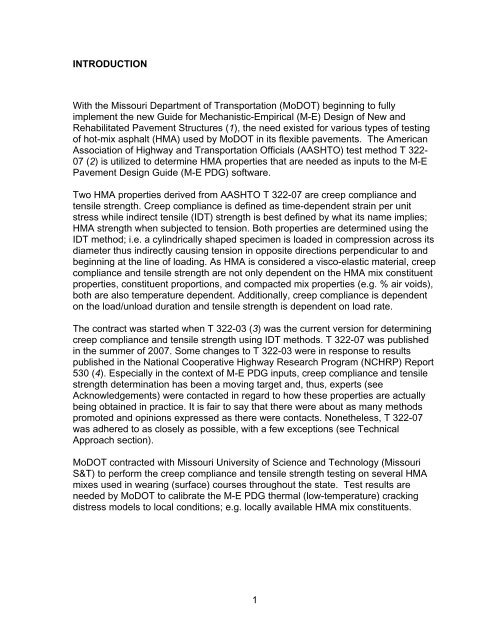Determination of Creep Compliance and Tensile Strength of Hot-Mix ...
Determination of Creep Compliance and Tensile Strength of Hot-Mix ...
Determination of Creep Compliance and Tensile Strength of Hot-Mix ...
- No tags were found...
Create successful ePaper yourself
Turn your PDF publications into a flip-book with our unique Google optimized e-Paper software.
INTRODUCTIONWith the Missouri Department <strong>of</strong> Transportation (MoDOT) beginning to fullyimplement the new Guide for Mechanistic-Empirical (M-E) Design <strong>of</strong> New <strong>and</strong>Rehabilitated Pavement Structures (1), the need existed for various types <strong>of</strong> testing<strong>of</strong> hot-mix asphalt (HMA) used by MoDOT in its flexible pavements. The AmericanAssociation <strong>of</strong> Highway <strong>and</strong> Transportation Officials (AASHTO) test method T 322-07 (2) is utilized to determine HMA properties that are needed as inputs to the M-EPavement Design Guide (M-E PDG) s<strong>of</strong>tware.Two HMA properties derived from AASHTO T 322-07 are creep compliance <strong>and</strong>tensile strength. <strong>Creep</strong> compliance is defined as time-dependent strain per unitstress while indirect tensile (IDT) strength is best defined by what its name implies;HMA strength when subjected to tension. Both properties are determined using theIDT method; i.e. a cylindrically shaped specimen is loaded in compression across itsdiameter thus indirectly causing tension in opposite directions perpendicular to <strong>and</strong>beginning at the line <strong>of</strong> loading. As HMA is considered a visco-elastic material, creepcompliance <strong>and</strong> tensile strength are not only dependent on the HMA mix constituentproperties, constituent proportions, <strong>and</strong> compacted mix properties (e.g. % air voids),both are also temperature dependent. Additionally, creep compliance is dependenton the load/unload duration <strong>and</strong> tensile strength is dependent on load rate.The contract was started when T 322-03 (3) was the current version for determiningcreep compliance <strong>and</strong> tensile strength using IDT methods. T 322-07 was publishedin the summer <strong>of</strong> 2007. Some changes to T 322-03 were in response to resultspublished in the National Cooperative Highway Research Program (NCHRP) Report530 (4). Especially in the context <strong>of</strong> M-E PDG inputs, creep compliance <strong>and</strong> tensilestrength determination has been a moving target <strong>and</strong>, thus, experts (seeAcknowledgements) were contacted in regard to how these properties are actuallybeing obtained in practice. It is fair to say that there were about as many methodspromoted <strong>and</strong> opinions expressed as there were contacts. Nonetheless, T 322-07was adhered to as closely as possible, with a few exceptions (see TechnicalApproach section).MoDOT contracted with Missouri University <strong>of</strong> Science <strong>and</strong> Technology (MissouriS&T) to perform the creep compliance <strong>and</strong> tensile strength testing on several HMAmixes used in wearing (surface) courses throughout the state. Test results areneeded by MoDOT to calibrate the M-E PDG thermal (low-temperature) crackingdistress models to local conditions; e.g. locally available HMA mix constituents.1
















